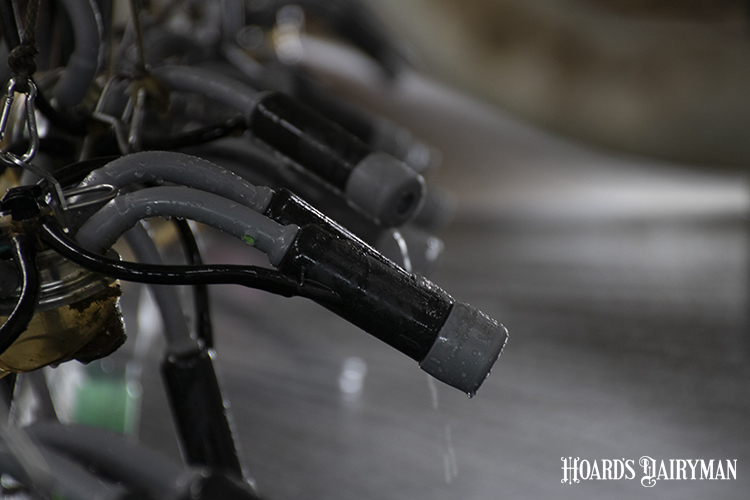
Like all dairy farmers, Scott Ferry keeps an eye out for any way to become more efficient on his family’s farm. One strategy he has adopted has raised milk production 2.5 pounds per cow per day and shortened milking time — all at no cost to the farm other than the effort to train employees in improving milk letdown stimulation.
The Litchfield, Mich., dairy participated in research done at Michigan State that examined bimodal milking, which occurs when cows do not have enough time to properly let their milk down in the parlor and consequently don’t milkout entirely. When the results of the research came back, Ferry Farms was having some bimodal milking issues, Ferry described on the November 17 Hoard’s Dairyman DairyLivestream sponsored by Diamond V.
“We needed to come up with a solution,” this dairyman knew.
A simple change
The farm, which milks about 500 cows 3x in a double-8 parlor, was already focusing on the importance of correct milking procedures, Ferry said. “We’ve always been heavily invested into having our protocols and our training refreshed and having these courses, so we were already talking about that 60-to-90 second prep time before attaching the unit to the cow,” he noted. “But this research really dialed that up a little bit further.”
The farm’s milking routine began with swiping a dry paper towel over the udder to remove any debris or bedding that came into the parlor, he explained. Then, each teat was cleaned, massaged, and forestripped. “We were doing that in about 10 seconds,” Ferry said. Milkers would go through the same routine on Cows 2, 3, and 4 before returning to the first to wipe teats with a microfiber towel and attach the unit.
Ferry noted that the parlor’s efficiency was important because they really only had time to wash up in between the three milkings. Additionally, he didn’t want to add another step to a process that he recognized was already tedious and sometimes exhausting for those who did the job every day. Finding a way to extend the prep time and improve stimulation to limit bimodal letdown had to check those boxes while also being simple to train and communicate.
“The thing that made the most sense was when I had that dry paper towel in my hand. It’s its own category of something to do in that process,” Ferry explained. Instead of just swiping the towel over the udder, they switched to deliberately touching each teat three times during that first contact. This added five seconds of stimulation time while not being any more tedious on the milkers or the teats, Ferry said. The rest of the procedure remained the same.
“It immediately worked,” Ferry said excitedly. “The cool thing is when I’m training folks in the milking parlor, it was very simple to see this instantaneous report card. I’d go in and do it wrong, and they could see in the milk claw that the milk would stop flowing. Then we’d go and do it right by adding that extra five seconds and boom, you’ve got that full on milk flow and everybody is immediately seeing that it works.”
Since cows are letting their milk down more thoroughly, they actually milkout faster even while producing more milk. “This provides additional quality of life to the people who are working with the cow,” Ferry described. “If I can get more milk per cow, I can ship the same amount of pounds with maybe less cows. It takes less time for me to milk all the cows, and folks that are here working can have more time to do something else.”
Because Ferry made an effort to effectively communicate all of these benefits with his employees while stressing that he was aiming to not create additional work, he said employee buy-in was easy. The double benefit of employees and cows both working to the best of their ability is a great feeling to be a part of, this dairyman said. And taking care of those details is what he continues to focus on to be successful moving forward.
“I really don’t care to milk more cows,” Ferry explained. “I want to milk Olympic-qualifying, podium-qualifying athletes. I want to be the most efficient I can be.”
To watch the recording of the November 17 DairyLivestream, go to the link above. The program recording is also available as an audio-only podcast on Spotify, Google Podcasts, Apple Podcasts, and downloadable from the Hoard’s Dairyman website.
An ongoing series of events
The next broadcast of DairyLivestream will be on Wednesday, December 8 at 11 a.m. CDT. Each episode is designed for panelists to answer over 30 minutes of audience questions. If you haven’t joined a DairyLivestream broadcast yet, register here for free. Registering once registers you for all future events.








